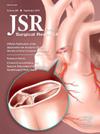System-level Variability in Trauma Center Utilization for Seriously Injured Older Adults
IF 1.7
3区 医学
Q2 SURGERY
引用次数: 0
Abstract
Introduction
Many seriously injured older adults are not transported to trauma centers (TCs), a phenomenon known as undertriage. System-level factors that contribute to undertriage are poorly understood. One important system-level factor is the regional supply of TCs. We hypothesized that regions with greater supply of TCs would have higher rates of transport to a TC for seriously injured older adults.
Methods
In this retrospective cross-sectional study using Medicare data from 2014 to 2015, we measured the proportion of seriously injured (injury severity score > 15) older adults (age ≥ 65 y) who were transported to a level I or level II TC within trauma service areas (TSAs), which consist of United States counties aggregated into contiguous geographic regions based on the most frequent hospital destinations for emergency conditions. Patients residing in rural regions were excluded. The primary outcome was transported to a level I or level II TC. The exposure was the supply of TCs within TSAs, grouped into terciles based on the number of TCs per capita. We performed a multivariable hierarchical logistic regression for the odds of TC transport with a random intercept for TSA and fixed effects for TC supply, patient demographics, and injury characteristics.
Results
Our study included 68,128 seriously injured older adults residing in 309 TSAs. The tercile of TSAs with the lowest supply of TCs had 1.13 TCs per 1,000,000 population, and 38.8% of seriously injured older adults were transported to a TC. In contrast, the tercile with the highest supply of TCs had 4.15 TCs per 1,000,000 population, and 68.5% were transported to a TC. On multivariable hierarchical logistic regression, TSAs with the highest supply of TCs had four times higher odds of transport to a TC compared to TSAs with the lowest supply of TCs (odds ratio 4.23; 95% confidence interval: 3.32-5.38; P < 0.001).
Conclusions
Older adults with serious injuries are more likely to be transported to a TC in TSAs with greater supply of TCs. Ensuring an appropriate supply of TCs within TSA regions may help to reduce rates of undertriage for seriously injured older adults.
重伤老年人创伤中心使用的系统级变异性
许多严重受伤的老年人没有被送往创伤中心(tc),这种现象被称为分流不足。导致分流不足的系统级因素了解甚少。一个重要的系统级因素是tc的区域供应。我们假设,在TC供应较多的地区,严重受伤的老年人转移到TC的比率也较高。方法采用2014 - 2015年医疗保险数据进行回顾性横断面研究,测量严重损伤患者的比例(损伤严重程度评分>;15)在创伤服务区(tsa)内被送往一级或二级TC的老年人(年龄≥65岁),这些创伤服务区由美国各县组成,根据急诊最常去的医院目的地聚集成连续的地理区域。排除居住在农村地区的患者。主要结局转移到I级或II级TC。受影响的是tsa内的TCs供应,按人均TCs数量分类。我们对TC转运的几率进行了多变量分层逻辑回归,对TSA进行了随机截距,对TC供应、患者人口统计学和损伤特征进行了固定影响。结果本研究纳入了309个TSAs的68128名严重受伤老年人。TCs供货量最低的tsa的数量为1.13 / 100万人口,38.8%的重伤老年人被转移到TCs。相比之下,TC供应量最高的地区每100万人口中有4.15个TC, 68.5%的人被运送到TC。在多变量分层逻辑回归中,tsa中TCs供应量最高的tsa转运到TC的几率是tsa供应量最低的tsa的4倍(优势比4.23;95%置信区间:3.32-5.38;P & lt;0.001)。结论在tsa中,由于TCs的供应较多,严重损伤的成人更容易被转移到TCs。确保运输安全管理局区域内适当的TCs供应可能有助于减少严重受伤的老年人的分类不足率。
本文章由计算机程序翻译,如有差异,请以英文原文为准。
求助全文
约1分钟内获得全文
求助全文
来源期刊
CiteScore
3.90
自引率
4.50%
发文量
627
审稿时长
138 days
期刊介绍:
The Journal of Surgical Research: Clinical and Laboratory Investigation publishes original articles concerned with clinical and laboratory investigations relevant to surgical practice and teaching. The journal emphasizes reports of clinical investigations or fundamental research bearing directly on surgical management that will be of general interest to a broad range of surgeons and surgical researchers. The articles presented need not have been the products of surgeons or of surgical laboratories.
The Journal of Surgical Research also features review articles and special articles relating to educational, research, or social issues of interest to the academic surgical community.

 求助内容:
求助内容: 应助结果提醒方式:
应助结果提醒方式:


